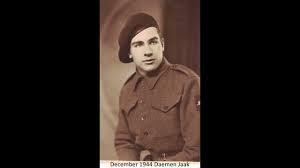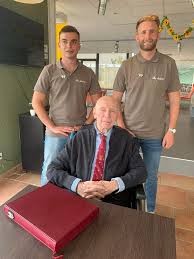WHO DARES WINS
Born in Leopoldsburg in the Limburg province of Belgian Flanders, Jaak’s father was a postmaster and grocery store manager.

Jaak was just sixteen when the Nazis invaded Belgium and he immediately joined the resistance. In his hometown, they were known as the ‘Secret Army of Leopoldsburg’ and they were very active.
Jaak delivered pamphlets and carried explosives which he had stolen from a local mine – and which was used to blow up bridges.
The most crucial bridge that was destroyed was at Balen. It was an important communication link for the occupiers.
Jaak did this for two years until three of his colleagues were betrayed and were arrested by the Nazis. He went into hiding.
In 1944, Jaak managed to escape to the UK. There, the Belgian Special Air Service (SAS) was being formed – and he signed up.

They were (reluctantly) trained by the British SAS at Malvern, and adopted the same motto, ‘Who Dares Wins’.
The recruits came from all walks of life and included lawyers, teachers, doctors, professional cyclists, three barons and even a circus acrobat. “The common point was a sporty background and strong character.”

They were led by Captain Eddy Blondeel, who had just completed a degree in dentistry at the University of Chicago.

The training was extremely rigorous. Several men died whilst learning to parachute.
The British government were reluctant to let the unit fight in their homeland, fearing the presence of men in uniform might lead to a Belgian uprising before the Allies were ready to invade and take on the Nazis.
Instead, the Belgian SAS were parachuted into Normandy to work with the French Resistance.
After that, they took part in Operation Larkswood alongside Polish airmen. This was the recapture of the North-Eastern Netherlands. The aim was to encircle the Nazis.

Jaak’s unit was dropped in deep behind enemy lines on 27th July 1944. They were ordered to capture a bridge at Veele, a hamlet just to the east of the city of Groningen. They were to use heavy force to push the Germans back, then swim the Mussel Canal and clear a passageway for others to attack the enemy.
Initially, it did not go well. They had no protection from enemy fire. Three men were killed (P. Rolin, J. Breuer and E. Hazard) and many more were wounded (a little local girl was also killed by a stray bullet). Jaak was in the very front line of attack.
Eventually, the Belgians received support from Polish and Canadian troops and the bridge was captured. The city of Groningen was liberated.
The Belgians were immediately marched away to fight elsewhere, so the Poles and Canadians received all the plaudits and credit for the assault and for ridding the city of its Nazi oppressors.
The group were involved in the liberation of the Netherlands and their native Belgium – and were the first Allied troops to enter Nazi Germany.
They captured Admiral Karl Donitz, the commander of the U-Boats, who had replaced Adolf Hitler as leader of Germany after the Fuhrer’s suicide.

They carried out sabotage on enemy troops, liberated many villages and hunted down Nazi war criminals.
Reflecting on his war experiences in later years, Jaak always said, “Freedom doesn’t always come for free. Sometimes you have to fight for it.”

By the time the war had finished, Jaak could speak seven languages fluently.
After the war, Jaak, now aged twenty-four, stayed in the military, training troops for the Force Publique in the Belgian colonies of Burundi and the Congo. He did this for twenty years.
Next, Jaak joined a travel company and acted as a tour guide to the Canary Islands and Italy.
However, through this time, Jaak was still working as an undercover agent for Belgian intelligence and was sent to conflict zones such as Morocco, Mauritania and the Balkans.
His wife and children had no idea about this secret life.
The Belgian SAS were not popular with the regular army and were disbanded and merged into other units.
In 1993, they were re-formed, once again with maroon berets and the motto ‘Who Dares Wins.
Jaak retired to his hometown of Leopoldsburg and became heavily involved in commemorative events for the fallen of the SAS – being asked to organise them by Colonel Blondeel. There was one in Veele each year, and others in both the Netherlands and his native Belgium.
Veele has renamed the famous bridge the SAS had fought over, as the Rolin Bridge, after Philippe Rolin, one of the three men who had died there.
Jaak was present when a statue was erected to Colonel Blondeel in front of the citadel at Diest, following the latter’s death in 2017. He gave a speech, dedicating the memorial.
In old age, Jaak suffered a terrible fall, which fractured the vertebra in his back. Consequently, he lived the last three years of his life in a care home. Whilst there, he said he would, ‘Keep fighting’.
Jaak was awarded the Belgian Medal of Honour. He was also given the freedom of Veele at a ceremony he was too ill and frail to attend, so his son received it in his stead.
At Jaak’s death aged 97, his son Marc said, “My father felt it was his duty to serve his country. He wanted his children and his descendants to live in freedom.”
Jaak was the last survivor of the Second World War Belgian SAS. He was buried with full military honours.
RIP = Relieving Invaded Provinces












































